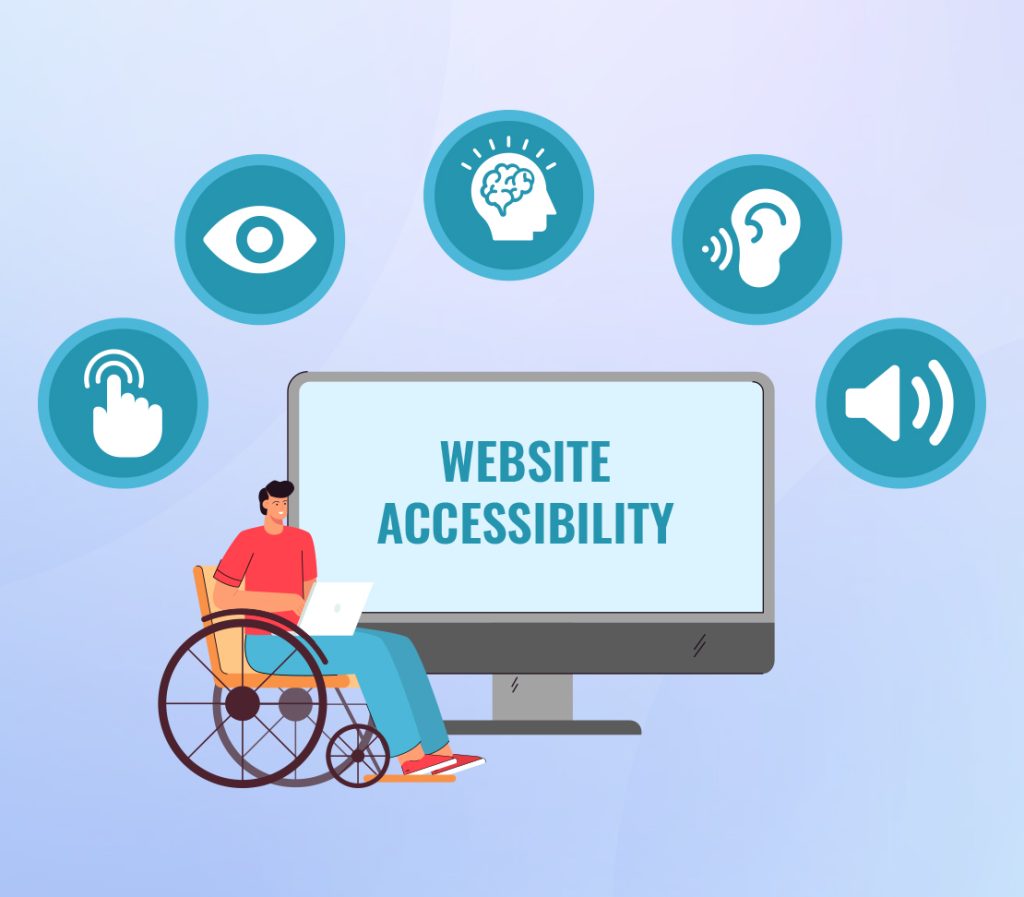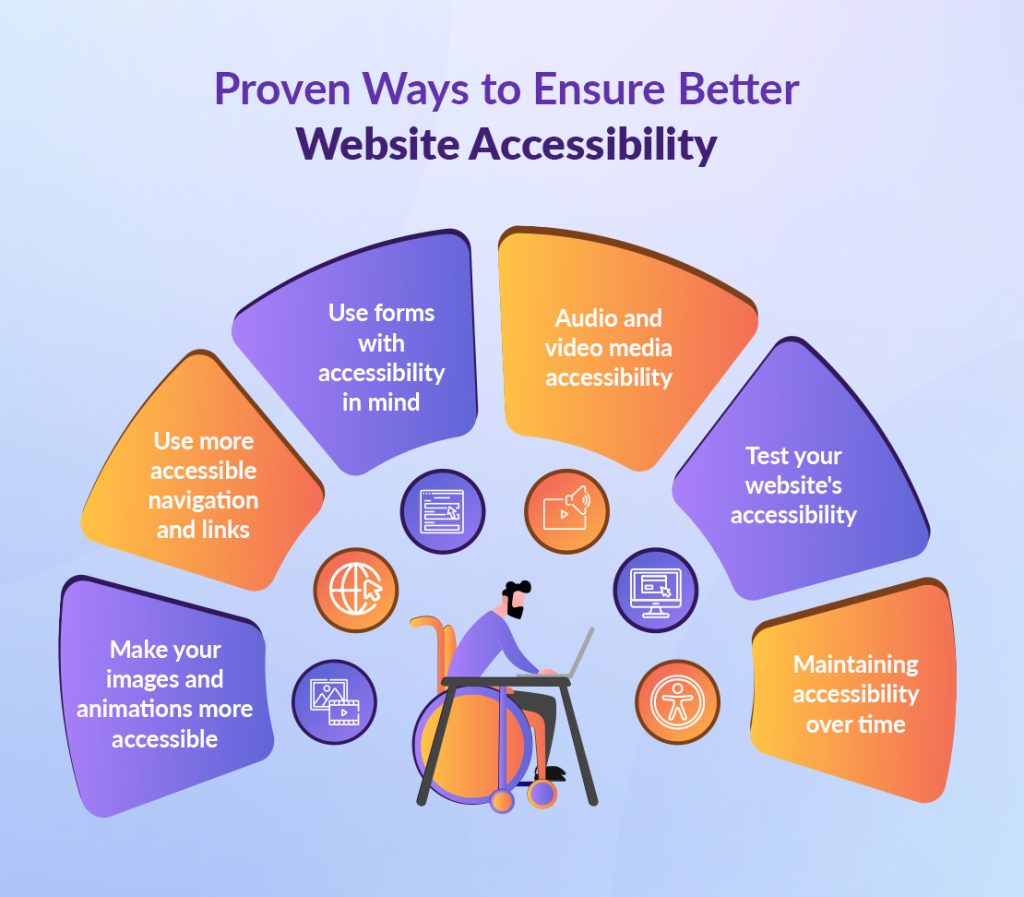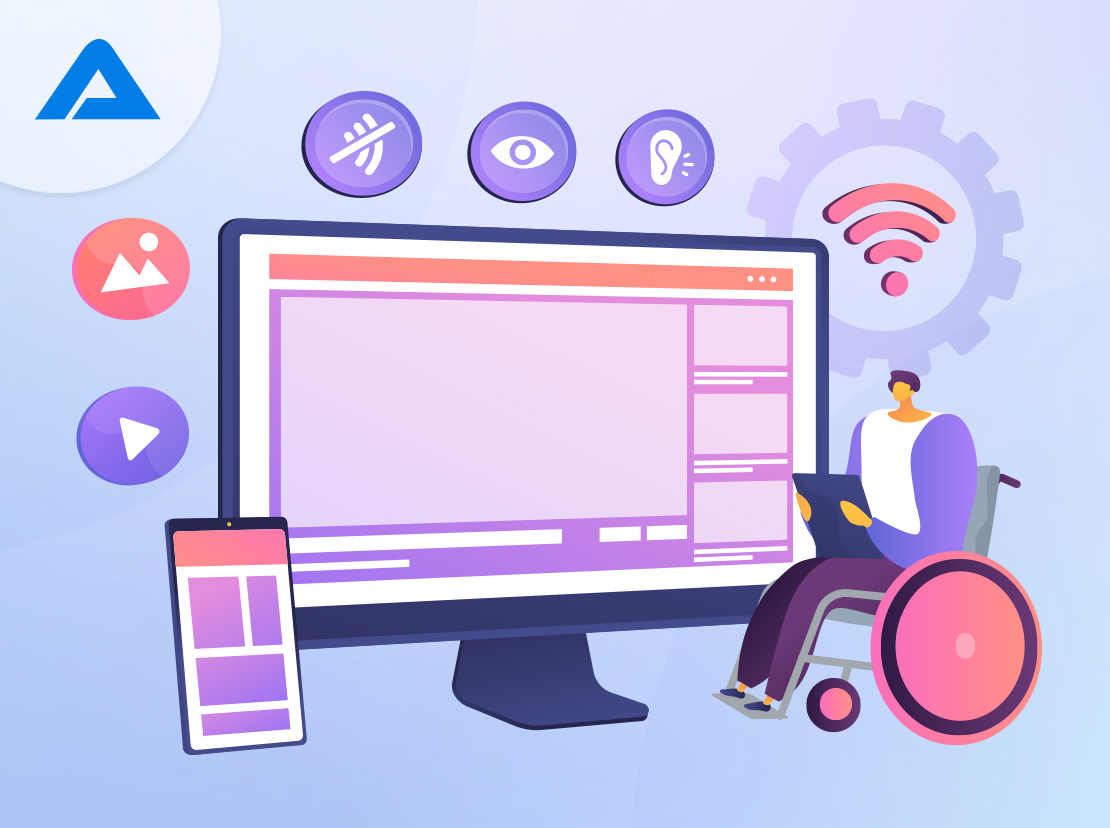Undoubtedly, accessibility should be one of the main priorities when building a website. In some countries, accessibility compliance is a legal requirement, b Not everyone has the same type of computer or phone, so it’s crucial to consider compatibility when creating audio and video content.ut it also makes your website more user-friendly for everyone.
After all, you want to serve everyone regardless of their abilities or disabilities.
The world has become more inclusive to people with disabilities than ever. And you need to be at the forefront of this as well.
As a business, inclusive web application development is the best way to make this world a better and more inclusive place. There are many ways to make a website more accessible, and it can be overwhelming to try and implement all of them simultaneously.
That’s why we’ve compiled a list of the top 6 accessibility tips you can use to make your website more inclusive.
What is Website Accessibility? Why Web Accessibility is Important?

Web accessibility means people with disabilities can use the Web just like everyone else.
In simpler words, web accessibility ensures people with disabilities can access, use, understand, and engage with the Web regardless of how they interact with the internet. And that they can do these things equally well as people without disabilities.
Web accessibility also benefits other users, including those using older browsers or mobile devices. It is also important to remember that people with disabilities may use assistive technologies to access the Web.
Assistive technologies include screen readers, Braille output devices, voice recognition software, and switch-operated input devices.
Equipping websites with accessibility technologies and means can help improve accessibility of a website.
Designing an Accessible Website
You should keep three key design considerations in mind when making your website accessible to as many people as possible.
- Your website must be easy to navigate for users with disabilities. This means ensuring that all links and buttons are clearly labeled and easy to find. You should also provide alternative text for images to help users who are blind or have low vision understand them.
- Your content should be designed using clear and concise language. This will help ensure that users with cognitive disabilities can still access and understand your content. Doing so will improve your website’s web content accessibility.
- You must ensure that users with various devices and browsers can access your website. This includes ensuring that your site is responsive and works well on mobile devices and desktop computers.
Related Article: The Most Common Website Redesign Blunders You Should Avoid
How to Make Your Website Accessible?
When designing a new website or redesigning an existing one, you need to consider a range of elements for better website accessibility.
Here are a few proven ways to ensure better website accessibility.

Images and animations
Images and animations are essential elements of any website, but they can also be a source of accessibility issues.
Make your images and animations more accessible with the following:
- Describe the images and animation you use with alternative (ALT) text. Doing so will help people who are blind or have low vision to understand what the image is about.
- Make sure your images and animations are correctly sized. If they’re too small, people with vision impairments will have difficulty seeing them. If they’re too large, they may take up too much space on the screen and be difficult to view for everyone.
- Avoid using flashing or blinking effects, as these can trigger seizures in people with photosensitive epilepsy. If you must use them, make sure they can be turned off or customized so that they don’t cause problems for people with this condition.
Use more accessible navigation and links.
The first thing you need to do to make your website more accessible is to ensure that all your navigation and links are accessible. This means that they should be easy to find and easy to use.
Here are a few things you can do to make sure your navigation and links are accessible:
- Use clear and concise labels for your navigation items.
- Use prominent and consistent placement for your navigation items.
- Make sure your links open in the same window or tab.
- Use descriptive link text, so users know where they will be taken when they click on a link.
Use forms with accessibility in mind.
Another essential thing to do to make your website accessible is to ensure that your forms are accessible. Forms are how users interact with your website; if they’re not accessible, it can be challenging for users with disabilities to use your site.
When using forms:
- Ensure that clear and concise labels are used for each form field.
- Make sure the form can be completed using only the keyboard.
- Use placeholder text wisely. Placeholder text should describe what data should be entered into a field but should not be used as actual data.
- Allow users to submit the form without JavaScript enabled.
- Provide feedback when a user completes a field correctly or incorrectly.
Audio and video media
Keep the following in mind when creating audio and video content for your website to ensure it is accessible to as many people as possible.
Provide transcripts of all audio content
This will allow people who are deaf or hard of hearing to access the information conveyed in the media. It will also be helpful for people who speak a different language or have difficulty understanding spoken English.
Provide captions for all video content
This will serve the same purpose as transcripts and will also be helpful for people who are trying to watch the video without sound.
Ensure playability on multi-platforms
You must ensure that the audio or video content you create can be played on various devices and platforms. Additionally, consider using an AI video generator to create different versions of your video content in multiple languages, further enhancing accessibility.
Related Article: A Detailed Guide to Find the Best Web App Development Partner for Your Startup?
Test your website’s accessibility
It is not enough to consider website accessibility when developing your website. You must also test it to see if it works as you envisaged it.
There are a few ways to test your website’s accessibility.
One is to use an online tool like the WAVE (Web Accessibility Evaluation Tool). This tool will analyze your web page and give you a report on any accessibility issues it finds.
Another way to test your website’s accessibility is by manually checking it yourself. You can do this by looking at your web page with a screen reader or using a keyboard instead of a mouse to navigate the site.
This will help you identify areas where people with disabilities might have difficulty using your site.
Maintaining accessibility over time.
As the internet and web technologies continue to evolve, it’s essential to consider how these changes might impact the accessibility of your website.
Although there are no hard and fast rules, here are a few general guidelines you can follow to help ensure that your site remains accessible over time:
Use standard web technologies.
While new web technologies are constantly emerging, it’s vital to use established standards whenever possible. This will help ensure that your site can be accessed by as many people as possible, now and in the future.
Avoid custom solutions
Custom solutions may work well for your specific needs, but they can often be difficult or impossible for others to access. If you need to use a custom solution, be sure to provide an accessible alternative.
Test regularly
Even if you don’t make any changes to your site, it’s essential to test it regularly for accessibility issues.
This way, you can identify any potential problems early on and take steps to fix them.
Conclusion
Websites should be accessible to everyone, regardless of their ability or disability. Following these tips can help create a website usable for everyone.
Making your website accessible is essential to reach a wider audience and ensure everyone can use and enjoy your site. Not only does it help you improve your brand logos and make people with disabilities want to use your products and services, which is good for your business.
Is your website accessible to everyone? If not, talk to our website development and design team to make your website accessible to everyone.
We would love to help you out here.
Frequently Asked Questions
Website accessibility refers to the inclusive design and development of websites to ensure they are usable by people of all abilities. It is essential for businesses as it promotes inclusivity and compliance with legal standards and expands the reach of their online presence.
Website accessibility benefits users with disabilities by providing them equal access to information and services. Common challenges include issues with navigation, insufficient text alternatives for images, and barriers to using keyboard or screen reader navigation.
The key principles of web accessibility, as defined by the Web Content Accessibility Guidelines (WCAG), include permeability, operability, understandability, and robustness. Businesses can apply these principles by designing clear interfaces, providing alternative text for images, and ensuring compatibility with assistive technologies.
To ensure permeability, businesses should use descriptive alt text for images, provide captions for multimedia content, use clear and readable fonts, and ensure sufficient colour contrast. These practices enhance the overall user experience for individuals with different abilities.
To enhance operability, businesses can implement keyboard navigation, ensure interactive elements are accessible via keyboard, avoid relying solely on mouse-based actions, and provide sufficient time for users to complete tasks.
To improve understandability, businesses should use clear and concise language, organize content logically, provide headings and labels that convey meaning, and avoid using jargon or complex terminology. These practices enhance comprehension for users with cognitive disabilities.
Consistent navigation is crucial for accessibility. Businesses can achieve this by using clear and predictable navigation menus, providing skip navigation links, and maintaining a consistent layout throughout the website. Consistency helps users easily navigate the site, especially those using screen readers.
Businesses can use automated accessibility testing tools like WAVE, Axe, or Lighthouse to identify common issues. Manual testing with assistive technologies and involving users with disabilities in usability testing also provide valuable insights into the accessibility of a website.
